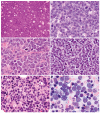B-cell lymphomas with concurrent IGH-BCL2 and MYC rearrangements are aggressive neoplasms with clinical and pathologic features distinct from Burkitt lymphoma and diffuse large B-cell lymphoma
- PMID: 20118770
- PMCID: PMC3152212
- DOI: 10.1097/PAS.0b013e3181cd3aeb
B-cell lymphomas with concurrent IGH-BCL2 and MYC rearrangements are aggressive neoplasms with clinical and pathologic features distinct from Burkitt lymphoma and diffuse large B-cell lymphoma
Abstract
B-cell lymphomas with concurrent IGH-BCL2 and MYC rearrangements, also known as "double-hit" lymphomas (DHL), are rare neoplasms characterized by highly aggressive clinical behavior, complex karyotypes, and a spectrum of pathologic features overlapping with Burkitt lymphoma (BL), diffuse large B-cell lymphoma (DLBCL) and B-lymphoblastic lymphoma/leukemia (B-LBL). The clinical and pathologic spectrum of this rare entity, including comparison to other high-grade B-cell neoplasms, has not been well defined. We conducted a retrospective analysis of clinical and pathologic features of 20 cases of DHL seen at our institution during a 5-year period. In addition, we carried out case-control comparisons of DHL with BL and International Prognostic Index (IPI)-matched DLBCL. The 11 men and 9 women had a median age of 63.5 years (range 32 to 91). Six patients had a history of grade 1 to 2 follicular lymphoma; review of the prior biopsy specimens in 2 of 5 cases revealed blastoid morphology. Eighteen patients had Ann Arbor stage 3 or 4 disease and all had elevated serum lactate dehydrogenase (LDH) levels at presentation. Extranodal disease was present in 17/20 (85%), bone marrow involvement in 10/17 (59%) and central nervous system (CNS) disease in 5/11 (45%). Nineteen patients were treated with combination chemotherapy, of whom 18 received rituximab and 14 received CNS-directed therapy. Fourteen patients (70%) died within 8 months of diagnosis. Median overall survival in the DHL group (4.5 mo) was inferior to both BL (P=0.002) and IPI-matched DLBCL (P=0.04) control patients. Twelve DHL cases (60%) were classified as B-cell lymphoma, unclassifiable, with features intermediate between DLBCL and BL, 7 cases (35%) as DLBCL, not otherwise specified, and 1 case as B-LBL. Distinguishing features from BL included expression of Bcl2 (P<0.0001), Mum1/IRF4 (P=0.006), Ki-67 <95% (P<0.0001), and absence of EBV-EBER (P=0.006). DHL commonly contained the t(8;22) rather than the t(8;14) seen in most BL controls (P=0.001), and exhibited a higher number of chromosomal aberrations (P=0.0009). DHL is a high-grade B-cell neoplasm with a poor prognosis, resistance to multiagent chemotherapy, and clinical and pathologic features distinct from other high-grade B-cell neoplasms. Familiarity with the morphologic and immunophenotypic spectrum of DHL is important in directing testing to detect concurrent IGH-BCL2 and MYC rearrangements when a karyotype is unavailable. The aggressive clinical behavior and combination of genetic abnormalities seen in these cases may warrant categorization as a separate entity in future classifications and call for novel therapeutic approaches.
Figures






References
-
- The International Non-Hodgkin’s Lymphoma Prognostic Factors Project A predictive model for aggressive non-Hodgkin’s lymphoma. N Engl J Med. 1993;329:987–994. - PubMed
-
- Boerma EG, Siebert R, Kluin PM, et al. Translocations involving 8q24 in Burkitt lymphoma and other malignant lymphomas: a historical review of cytogenetics in the light of today’s knowledge. Leukemia. 2009;23:225–234. - PubMed
-
- Brito-Babapulle V, Crawford A, Khokhar T, et al. Translocations t(14;18) and t(8;14) with rearranged bcl-2 and c-myc in a case presenting as B-ALL (L3) Leukemia. 1991;5:83–87. - PubMed
-
- Cogliatti SB, Novak U, Henz S, et al. Diagnosis of Burkitt lymphoma in due time: a practical approach. Br J Haematol. 2006;134:294–301. - PubMed
-
- Cox DR. Partial likelihood. Biometrika. 1975;62:277–288.
Publication types
MeSH terms
Substances
Grants and funding
LinkOut - more resources
Full Text Sources
Other Literature Sources
Miscellaneous

